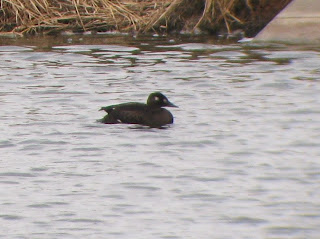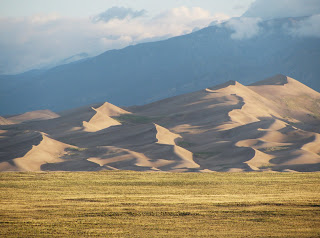 This afternoon while sitting in a hunting blind near my bird feeders I spotted a small and very well camouflaged Brown Creeper working his way up a nearby tree looking for food. I got a photo (left; click on it for a closer look) which shows very well just how hard they can be to see when the are up next to tree bark. The creepers are hard to detect also because their calls are generally hard to hear due to how high pitched and quiet they are. The Brown Creeper spends most of it's life attached to the bark of trees, not only while feeding but while nesting as well-they put their nest behind a loose piece of bark on a tree. Although small this is one impressive bird and one of my favorite.
This afternoon while sitting in a hunting blind near my bird feeders I spotted a small and very well camouflaged Brown Creeper working his way up a nearby tree looking for food. I got a photo (left; click on it for a closer look) which shows very well just how hard they can be to see when the are up next to tree bark. The creepers are hard to detect also because their calls are generally hard to hear due to how high pitched and quiet they are. The Brown Creeper spends most of it's life attached to the bark of trees, not only while feeding but while nesting as well-they put their nest behind a loose piece of bark on a tree. Although small this is one impressive bird and one of my favorite.On the opposite end of the spectrum a large, easy to see, and not very well camouflaged Blue Jay came by as well. The picture below is the first really nice Blue Jay shot I have taken because they are so easily spooked. Unfortunately there was no sign of the titmouse which I saw the morning before:( 





 Butterfly Milkweed (above)
Butterfly Milkweed (above) Hoary Puccoon
Hoary Puccoon Prairie Phlox
Prairie Phlox





 After dinner at the restaurant we parked the motor home at a campground just outside the park. I took the picture below the next morning. It is of the view from the our campsite!
After dinner at the restaurant we parked the motor home at a campground just outside the park. I took the picture below the next morning. It is of the view from the our campsite! 

 It was very windy out and it was hard to walk in the sand even on the flats below the dunes not to mention hiking up a very steep hill of it. Somehow I managed to survive the climb up. My camera was having a hard time with the sand. The wind was blowing some grains around where the lens comes out making it almost impossible for it to open up for some time. I did manage to fix the camera which is working just fine today. The photo below is one of my favorite photos I took while I was up in the dunes. I love that you can see my footprints, that the clouds seem to be getting blown up over the dunes, and the fact that the lighting was great and the skies were dark blue. A lovely picture indeed!
It was very windy out and it was hard to walk in the sand even on the flats below the dunes not to mention hiking up a very steep hill of it. Somehow I managed to survive the climb up. My camera was having a hard time with the sand. The wind was blowing some grains around where the lens comes out making it almost impossible for it to open up for some time. I did manage to fix the camera which is working just fine today. The photo below is one of my favorite photos I took while I was up in the dunes. I love that you can see my footprints, that the clouds seem to be getting blown up over the dunes, and the fact that the lighting was great and the skies were dark blue. A lovely picture indeed! The view from the top of the dunes was pretty neat. The photo below shows the visitor center, parking lot, etc. As you can tell it is a long ways down from the top.
The view from the top of the dunes was pretty neat. The photo below shows the visitor center, parking lot, etc. As you can tell it is a long ways down from the top. The time came for me to leave the dunes. On my way down to the parking lot I found a Circus Beetle which is one of the eight endemic insect species that inhabit the dunes. Just several days after playing around at the dunes I got a grain of sand in my eye which I had to get removed for a whopping $250. That is a bit much for one piece of sand don't you think? Although we are not sure where the sand came from my mom and I like to think it was from the sand dunes.
The time came for me to leave the dunes. On my way down to the parking lot I found a Circus Beetle which is one of the eight endemic insect species that inhabit the dunes. Just several days after playing around at the dunes I got a grain of sand in my eye which I had to get removed for a whopping $250. That is a bit much for one piece of sand don't you think? Although we are not sure where the sand came from my mom and I like to think it was from the sand dunes. 



 The same day I found a Northern Shrike which was the first of the fall. The bird stuck around until the next morning when it finally flew off. Of course I don't want to forget to talk about those 104 Smith's Longspurs! They are pretty awesome as well. Here is a photo of one in flight which is unfortunately the only one that I got.
The same day I found a Northern Shrike which was the first of the fall. The bird stuck around until the next morning when it finally flew off. Of course I don't want to forget to talk about those 104 Smith's Longspurs! They are pretty awesome as well. Here is a photo of one in flight which is unfortunately the only one that I got. Now I better not forget about the adult Northern Goshawk seen the next day. While looking for the Scissor-tailed Flycatcher my friend Paul spotted an adult goshawk in the vicinity where the flycatcher was at. I got to see it in a scope very well and was very excited to see such a hard to find bird being so cooperative for everyone there. I got one good photo but even the photo I got wasn't too great. I guess I'll label it a record shot.
Now I better not forget about the adult Northern Goshawk seen the next day. While looking for the Scissor-tailed Flycatcher my friend Paul spotted an adult goshawk in the vicinity where the flycatcher was at. I got to see it in a scope very well and was very excited to see such a hard to find bird being so cooperative for everyone there. I got one good photo but even the photo I got wasn't too great. I guess I'll label it a record shot. Well that is a short summary of how my October went. Hopefully I will be able to blog some more this month and maybe I will be able to finish posting about my New Mexico trip that I took in July!
Well that is a short summary of how my October went. Hopefully I will be able to blog some more this month and maybe I will be able to finish posting about my New Mexico trip that I took in July!